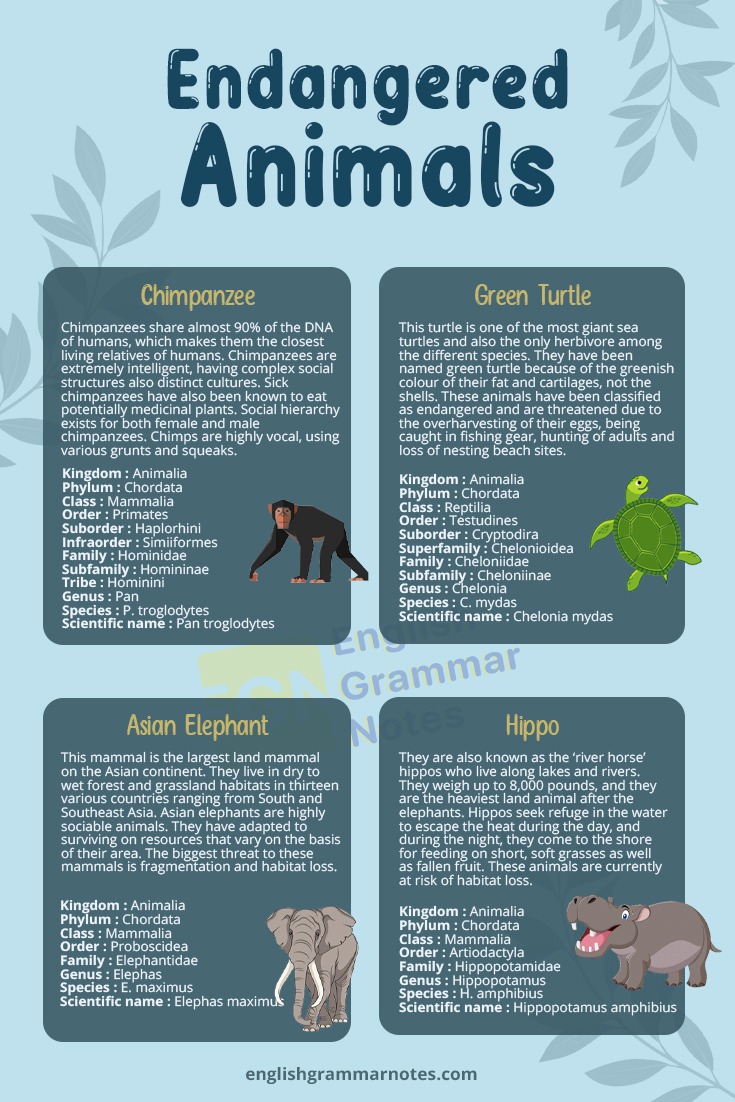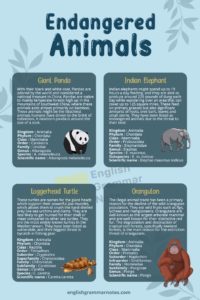Endangered Animals: Humans have exploited animals for ages, and this has led to the extinction of many species. This has caused a threat to the life of many existing species making them the most endangered animals. The biggest threats to their lives are hunting them for their body parts and habitat loss.
However, many countries have enforced laws to protect these endangered species from going extinct. Some of the animals which are on the list of threatened species have been mentioned below. In this article, we have made a list of endangered animals, which will help you in having a better understanding of the threats to these animals.
Study the most important English Vocabulary Words identified by our experts and learn the right vocabulary to use in your day to day conversations
List of Endangered Animals
Name of animals that are endangered
- Chimpanzee
- Green Turtle
- Asian Elephant
- Hippo
- Giant Panda
- Indian Elephant
- Loggerhead Turtle
- Orangutan
- Black Rhino
- Mountain Gorilla
- Sea Lions
- Tiger
- Great White Shark
Description of endangered animals on the list
Chimpanzee
Chimpanzees share almost 90% of the DNA of humans, which makes them the closest living relatives of humans. Chimpanzees are extremely intelligent, having complex social structures also distinct cultures. Sick chimpanzees have also been known to eat potentially medicinal plants. Social hierarchy exists for both female and male chimpanzees. Chimps are highly vocal, using various grunts and squeaks.
| Kingdom | Animalia |
| Phylum | Chordata |
| Class | Mammalia |
| Order | Primates |
| Suborder | Haplorhini |
| Infraorder | Simiiformes |
| Family | Hominidae |
| Subfamily | Homininae |
| Tribe | Hominini |
| Genus | Pan |
| Species | P. troglodytes |
| Scientific name | Pan troglodytes |
Green Turtle
This turtle is one of the most giant sea turtles and also the only herbivore among the different species. They have been named green turtle because of the greenish colour of their fat and cartilages, not the shells. These animals have been classified as endangered and are threatened due to the overharvesting of their eggs, being caught in fishing gear, hunting of adults and loss of nesting beach sites.
| Kingdom | Animalia |
| Phylum | Chordata |
| Class | Reptilia |
| Order | Testudines |
| Suborder | Cryptodira |
| Superfamily | Chelonioidea |
| Family | Cheloniidae |
| Subfamily | Cheloniinae |
| Genus | Chelonia |
| Species | C. mydas |
| Scientific name | Chelonia mydas |
Asian Elephant
This mammal is the largest land mammal on the Asian continent. They live in dry to wet forest and grassland habitats in thirteen various countries ranging from South and Southeast Asia. Asian elephants are highly sociable animals. They have adapted to surviving on resources that vary on the basis of their area. The biggest threat to these mammals is fragmentation and habitat loss.
| Kingdom | Animalia |
| Phylum | Chordata |
| Class | Mammalia |
| Order | Proboscidea |
| Family | Elephantidae |
| Genus | Elephas |
| Species | E. maximus |
| Scientific name | Elephas maximus |
Hippo
They are also known as the ‘river horse’ hippos who live along lakes and rivers. They weigh up to 8,000 pounds, and they are the heaviest land animal after the elephants. Hippos seek refuge in the water to escape the heat during the day, and during the night, they come to the shore for feeding on short, soft grasses as well as fallen fruit. These animals are currently at risk of habitat loss.
| Kingdom | Animalia |
| Phylum | Chordata |
| Class | Mammalia |
| Order | Artiodactyla |
| Family | Hippopotamidae |
| Genus | Hippopotamus |
| Species | H. amphibius |
| Scientific name | Hippopotamus amphibius |

Giant Panda
With their black and white coat, Pandas are adored by the world and considered a national treasure in China. Pandas are native to mainly temperate forests high up in the mountains of southwest China, where these animals exist almost primarily on bamboo. These animals might be the kitschiest animals humans have driven to the brink of extinction. A newborn panda is around the size of a stick.
| Kingdom | Animalia |
| Phylum | Chordata |
| Class | Mammalia |
| Order | Carnivora |
| Family | Ursidae |
| Genus | Ailuropoda |
| Species | A. melanoleuca |
| Scientific name | Ailuropoda melanoleuca |
Indian Elephant
Indian elephants might spend up to 19 hours a day feeding, and they are able to produce around 220 pounds of dung each day while wandering over an area that can cover up to 125 square miles. These feed on primary grasses but also significant amounts of roots, tree bark, leaves and small stems. They have been listed as endangered animals due to the threat to their kind.
| Kingdom | Animalia |
| Phylum | Chordata |
| Class | Mammalia |
| Order | Proboscidea |
| Family | Elephantidae |
| Genus | Elephas |
| Species | E. maximus |
| Subspecies | E. m. indicus |
| Scientific name | Elephas maximus indicus |
Loggerhead Turtle
These turtles are names for the giant heads which support their powerful jaw muscles, which allows them to crush the hard-shelled prey like sea urchins and clams. They are less likely to get hunted for their shell or meat compared to other sea turtles. They are the most widely known turtles in the Mediterranean. They have been listed as vulnerable, and their biggest threat is bycatch in fishing gear.
| Kingdom | Animalia |
| Phylum | Chordata |
| Class | Reptilia |
| Order | Testudines |
| Suborder | Cryptodira |
| Superfamily | Chelonioidea |
| Family | Cheloniidae |
| Subfamily | Carettinae |
| Genus | Caretta |
| Species | C. caretta |
| Scientific name | Caretta caretta |
Orangutan
The illegal animal trade has been a primary reason for the decline of the wild orangutan population. They eat wild fruits such as figs, lychees and mangosteens. Orangutans are well-known as the largest arboreal mammal and are well known for their distinctive red fur. The degradation and destruction of tropical rain forests, specifically lowland forests, is the main reason for the extinction threat of orangutans.
| Kingdom | Animalia |
| Phylum | Chordata |
| Class | Mammalia |
| Order | Primates |
| Suborder | Haplorhini |
| Infraorder | Simiiformes |
| Family | Hominidae |
| Subfamily | Ponginae |
| Genus | Pongo |
| Scientific name | Pongo |

Black Rhino
Classified as critically endangered, these rhinos are the smaller of both African rhino species. Their most significant difference from a white rhino is their hooked upper lip, whereas white rhinos have a square lip. Their pointed tips help them feed on leaves from trees and bushes. They usually have two horns and sometimes a third, small posterior horn. Their average life span is around 35 to 50 years.
| Kingdom | Animalia |
| Phylum | Chordata |
| Class | Mammalia |
| Order | Perissodactyla |
| Family | Rhinocerotidae |
| Genus | Diceros |
| Species | D. bicornis |
| Scientific name | Diceros bicornis |
Mountain Gorilla
These apes are glorious, great, fur-coated and are some of our closest relatives. There are only around 1,000 of these magnificent beasts living in the wild. The main threat to these mountain gorillas is humans and the associated increasing pressure on the habitat of the gorillas. These animals have been listed as critically endangered. However, the good news is that the numbers have been growing.
| Kingdom | Animalia |
| Phylum | Chordata |
| Class | Mammalia |
| Order | Primates |
| Suborder | Haplorhini |
| Infraorder | Simiiformes |
| Family | Hominidae |
| Subfamily | Homininae |
| Genus | Gorilla |
| Species | G. beringei |
| Subspecies | G. b. beringei |
| Scientific name | Gorilla beringei beringei |
Sea Lions
These marine creatures haul out in big colonies on sandy shores and rocks on the islands. They get inside the water to eat and cool off as required. Sea lions are vulnerable to the effects of climate change on the ocean currents, impacting their fish prey abundance. They also fall victim to bycatch in fisheries. There are only around 10,000 of these creatures left.
| Kingdom | Animalia |
| Phylum | Chordata |
| Class | Mammalia |
| Order | Carnivora |
| Clade | Pinnipedia |
| Family | Otariidae |
| Subfamily | Otariinae |
| Scientific name | Otariinae |
Tiger
These Asian nig cats have been listed as endangered. Tigers have been classified as endangered due to several factors such as illegal trade of tiger body parts, poaching, human conflict, loss of habitat as well as climate change. However, after an entire century of decline, the wild tigers in the wild are starting to go up. It has been estimated that 3,900 tigers are remaining in the world.
| Kingdom | Animalia |
| Phylum | Chordata |
| Class | Mammalia |
| Order | Carnivora |
| Suborder | Feliformia |
| Family | Felidae |
| Subfamily | Pantherinae |
| Genus | Panthera |
| Species | P. tigris |
| Scientific name | Panthera tigris |
Great White Shark
This is the world’s largest known predatory fish, having 300 teeth and still not chewing their food. The great white shark is a vulnerable species. These animals are under special protection. Even though some countries have banned the fishing of white sharks, other countries continue to harvest them from the oceans. They are hunted mainly for their teeth and bones.
| Kingdom | Animalia |
| Phylum | Chordata |
| Class | Chondrichthyes |
| Order | Lamniformes |
| Family | Lamnidae |
| Genus | Carcharodon |
| Species | C. carcharias |
| Scientific name | Carcharodon carcharias |